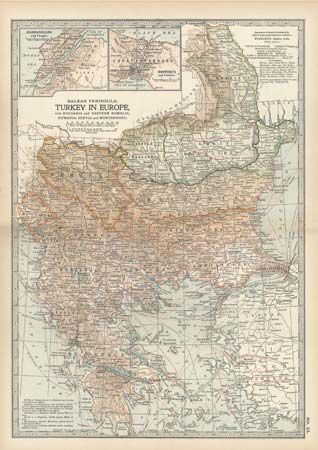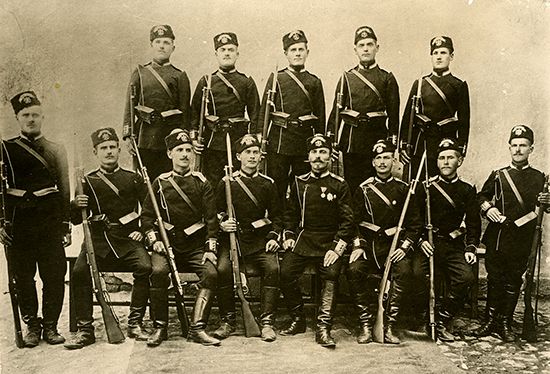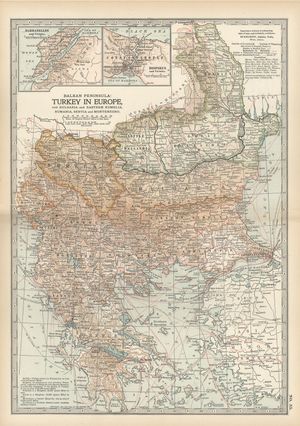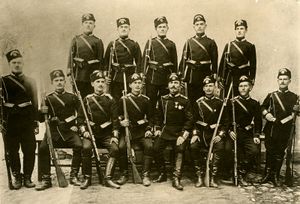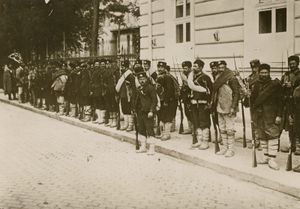Balkan Wars
- Date:
- October 8, 1912 - May 30, 1913
- June 29, 1913 - August 10, 1913
- Location:
- Balkans
- Kosovo
- Skopje
- Thessaloníki
- Thrace
- Participants:
- Bulgaria
- Greece
- Montenegro
- Ottoman Empire
- Romania
- Serbia
- Context:
- Balkan League
- Young Turks
Balkan Wars, (1912–13), two successive military conflicts that deprived the Ottoman Empire of all its remaining territory in Europe except part of Thrace and the city of Adrianople (Edirne). The second conflict erupted when the Balkan allies Serbia, Greece, and Bulgaria quarreled over the partitioning of their conquests. The result was a resumption of hostilities in 1913 between Bulgaria on the one hand and Serbia and Greece, which were joined by Romania, on the other.
Origin of the Balkan Wars
The Balkan Wars had their origin in the discontent produced in Serbia, Bulgaria, and Greece by disorder in Macedonia. The Young Turk Revolution of 1908 brought into power in Constantinople (now Istanbul) a ministry determined on reform but insisting on the principle of centralized control. There were, therefore, no concessions to the Christian nationalities of Macedonia, which consisted not only of Macedonians but also of Serbs, Bulgarians, Greeks, and Vlachs. The Albanians, whose growing sense of nationalism had been awakened by the Albanian League, were likewise discontented with the Young Turks’ centralist policy.
The Internal Macedonian Revolutionary Organization (IMRO), founded in 1893, organized bands to resist the Turkish administration. Clashes not only exacerbated feelings within Macedonia but also roused public opinion in Bulgaria in favour of intervention. The IMRO became a powerful factor in Bulgarian politics. A similar development occurred in Serbia, where the patriotic society Narodna Odbrana (“National Defense”), invigorated by the infiltration of the “Union or Death” group (founded in May 1911 and better known as the Black Hand), was active not only within the Serbian administration but also in organizing Serbian resistance in Macedonia. The activity of the Bulgarians in Macedonia had led in September 1903 to the formation of an armed band in defense of Greek interests, but the Greek government was equally determined to extend its territory in the Aegean Islands and to secure union with Crete. At first, Greeks, Serbs, and Bulgarians frequently acted in opposition to one another, but the events of 1911 brought them to realize that the main enemy was the Turks and that they could achieve freedom only by a common understanding.
International circumstances were of considerable importance. Austria-Hungary had in October 1908 annexed Bosnia and Herzegovina, territory that was legally part of the Ottoman Empire but under Austro-Hungarian occupation and administration after the Congress of Berlin (1878). The Austro-Hungarian government, moreover, had a treaty right to occupy the sanjak (district) of Novi Pazar, which separated Montenegro from Serbia. Deeply resentful of Austria-Hungary’s action, which excluded an eventual union of the inhabitants of Bosnia and Herzegovina with Serbia, the Serbian government nevertheless realized that it could not challenge one of the great powers. It therefore turned its attention to Macedonia, where a weaker power like Turkey could more easily be attacked if an alliance could be achieved with Bulgaria. The Agadir Incident of 1911, moreover, revealed that the two great-power groupings, the Triple Alliance and the Triple Entente, were evenly balanced, so that the small powers might exercise some measure of individual initiative.
The First Balkan War
The First Balkan War was fought between the members of the Balkan League—Serbia, Bulgaria, Greece, and Montenegro—and the Ottoman Empire. The Balkan League was formed under Russian auspices in the spring of 1912 to take Macedonia away from Turkey, which was already involved in a war with Italy. The league was able to field a combined force of 750,000 men. Montenegro opened hostilities by declaring war on Turkey on October 8, 1912, and the other members of the league followed suit 10 days later.
The Balkan allies were soon victorious. In Thrace the Bulgarians defeated the main Ottoman forces, advancing to the outskirts of Constantinople and laying siege to Adrianople (Edirne). In Macedonia the Serbian army achieved a great victory at Kumanovo that enabled it to capture Bitola and to join forces with the Montenegrins and enter Skopje. The Greeks, meanwhile, occupied Salonika (Thessaloníki) and advanced on Ioánnina. In Albania the Montenegrins besieged Shkodër and the Serbs entered Durrës.
The Turkish collapse was so complete that all parties were willing to conclude an armistice on December 3, 1912. A peace conference was begun in London, but, after a coup d’état by the Young Turks in Constantinople in January 1913, war with the Ottomans was resumed. Again the allies were victorious: Ioánnina fell to the Greeks and Adrianople to the Bulgarians. Under a peace treaty signed in London on May 30, 1913, the Ottoman Empire lost almost all of its remaining European territory, including all of Macedonia and Albania. Albanian independence was insisted upon by the European powers, and Macedonia was to be divided among the Balkan allies.
The Second Balkan War
The Second Balkan War began when Serbia, Greece, and Romania quarreled with Bulgaria over the division of their joint conquests in Macedonia. On June 1, 1913, Serbia and Greece formed an alliance against Bulgaria, and the war began on the night of June 29–30, 1913, when King Ferdinand of Bulgaria ordered his troops to attack Serbian and Greek forces in Macedonia. The Bulgarian offensive, benefiting by surprise, was initially successful, but Greek and Serbian defenders retired in good order.
The Serbian army counterattacked on July 2 and drove a wedge into the Bulgarian line. Greek reserves advanced to the front on July 3, and a series of attacks over the following days threatened to turn the left flank of an entire Bulgarian army. In an effort to save their force from being cut off entirely, the Bulgarians launched a desperate attack on the Serbian lines. Once again, the Bulgarians achieved momentary success, but by July 10 the offensive had completely stalled. On July 11 the Romanian army crossed the Bulgarian frontier and began an unopposed march on Sofia, the Bulgarian capital. The following day, the Turks violated their armistice with Bulgaria and entered Thrace. The Greeks and the Serbs launched a general offensive on July 15, and the Turks reoccupied Adrianople on July 22. With enemy columns converging on Sofia, the Bulgarians bowed to the inevitable. On July 30 they concluded an armistice to end hostilities, and a peace treaty was signed between the combatants on August 10, 1913. Under the terms of the treaty, Greece and Serbia divided most of Macedonia between themselves, leaving Bulgaria with only a small part of the region.
Results of the Balkan Wars
As a result of the Balkan Wars, Greece gained southern Macedonia as well as the island of Crete. Serbia gained the Kosovo region and extended into northern and central Macedonia. Albania was made an independent state under a German prince.
The political consequences of the wars were considerable. Apart from Turkey, the real loser was Austria-Hungary. The partitioning of the sanjak of Novi Pazar between Serbia and Montenegro made it impossible in the subsequent crisis of June–July 1914 for Austria-Hungary to intervene in the Balkans. The Austro-Hungarian ultimatum to Serbia on July 23, 1914, was thus made to appear as naked aggression. The wars likewise altered the structure of alliances in the Balkans. Dissatisfied Bulgaria henceforth looked to Austria-Hungary for support, whereas Romania tended to move out of the influence of the Triple Alliance and toward the Triple Entente. The Turks, moreover, began to put their house in order and secured in November 1913 the services of German Gen. Otto Liman von Sanders with a group of technical advisers to strengthen the organization of their army.
The most alarming aspect of the war was the growth of tension between Austria-Hungary and Serbia. Serbia had extensive claims upon Albanian territory. Having obtained an assurance of German support, Austria-Hungary delivered an ultimatum on October 17, 1913, to compel Serbia to withdraw from the Albanian borderlands. This, however, did not solve for Austria-Hungary the Southern Slav question, which emerged again in an acute form with the assassination of the Austrian archduke Franz Ferdinand by a Serb on June 28, 1914, in Sarajevo, Bosnia.
The Editors of Encyclopaedia Britannica

